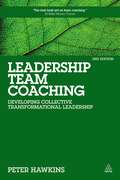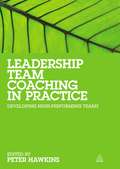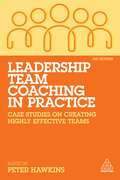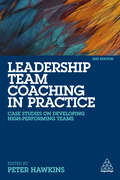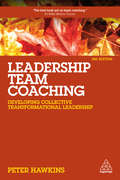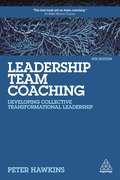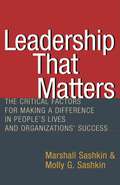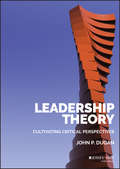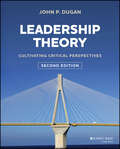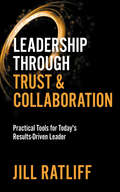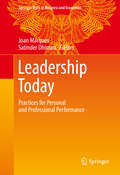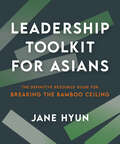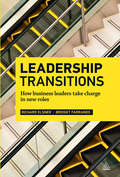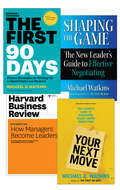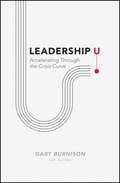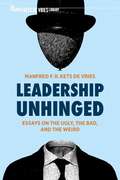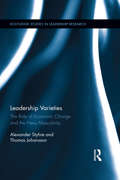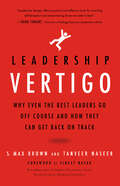- Table View
- List View
Leadership Team Coaching
by Peter HawkinsOrganizations are most effective when the teams responsible for the organization's success are performing to their maximum potential. If the relationships within a team work well, and all team members have a clear focus, this has a significant positive impact on achieving goals and delivering results. Leadership Team Coaching takes an integrated, systemic approach which provides a thorough understanding of the role and importance of the team to organizational objectives, offering the practical tools and techniques essential to facilitate optimum team performance through transformational leadership. Peter Hawkins draws on the latest research to give a practical roadmap for developing people from disparate groups into a high performing team that can transform your business. This second edition includes new chapters on how to select the players for a high performing team, and on how CEOs can develop effective teams with shared leadership, as well as new international case studies.
Leadership Team Coaching in Practice
by Peter HawkinsLeadership Team Coaching in Practice looks at how leadership team coaching techniques have been applied internationally across a variety of team types and sectors. With expert contributors including chief executives, team coaches, team leaders and consultants, this practical guide offers a range of real case studies to illustrate best practice with a detailed analysis of methods and processes tailored to the needs of each organization. Readers will learn how to develop their own unique approach to fostering collective transformational leadership across teams, whatever their business sector and whatever type of team they lead. The book can be used either as a stand-alone workbook or as a practical companion to Leadership Team Coaching, which offers a comprehensive introduction to creating and developing high performing teams through transformational leadership.
Leadership Team Coaching in Practice: Case Studies on Creating Highly Effective Teams
by Peter HawkinsA high-performing and cohesive leadership team is essential for organizational success. Leadership Team Coaching in Practice provides an overview of the tools and techniques for coaching leadership teams and shows how these approaches have been applied around the world in a variety of team types and industries.Featuring expert contributions from chief executives, team coaches, team leaders and consultants in organizations including Comair and the UK National Health Service (NHS), this practical guide illustrates best practice tailored to the needs of each organization. The new and updated third edition of Leadership Team Coaching in Practice incorporates the latest research and thinking in the field, including new material on developing the personal core capacities for systemic team coaching.Alongside updates to case studies to offer a long-term view of interventions, the third edition contains new case studies including team coaching in Toyota through a period of transformation. There is a new medley chapter of short case stories that address some of the regularly asked questions by new team coaches and new material that explores ways of creating a teaming and 'team of teams' culture. This book remains an essential resource for executive and team coaches, CEOs, team leaders, organizational development consultants, and those studying coaching as part of a degree or coaching qualification.
Leadership Team Coaching in Practice: Case Studies on Developing High-Performing Teams
by Peter HawkinsOrganizations are increasingly complex, requiring flexibility to implement significant, rapid change that goes beyond the ability of an individual leader or CEO. A high-performing and cohesive leadership team is critical for success. Leadership Team Coaching in Practice presents enlightening case studies on how leadership team coaching techniques have been applied internationally across a variety of team types and industries, including professional services, pharmaceuticals, airlines, healthcare and finance. With expert contributions from chief executives, team coaches, team leaders and consultants, this practical guide illustrates best practice tailored to the needs of each organization. This fully updated 2nd edition of Leadership Team Coaching in Practice includes new case studies and addresses hot topics in systemic leadership coaching theory. Answering questions such as how do you get the most from working across multiple teams? how should inter-team coaching be approached? and how do you coach millennials and tech start-ups?, it helps foster collective transformational leadership, whatever the business sector and type of team. Ideal for executive coaches, organizational development consultants (OD), HR leaders and aspiring managers, it shows how to develop leadership teams that can implement strategic change effectively and sustain competitive advantage.
Leadership Team Coaching: Developing Collective Transformational Leadership
by Peter HawkinsOrganizations are most effective when the teams responsible for their success function to the best of their ability. When the relationships within the team work well and all members have a clear focus, the team is able to achieve goals more easily. Leadership Team Coaching is a roadmap for those who have the responsibility of developing a leadership team. It provides a thorough explanation of the key elements of team coaching and is filled with practical tools and techniques to facilitate optimum performance across virtual teams, international teams, executive boards and other teams. The fully updated 3rd edition of Leadership Team Coaching brings together the latest research in leadership teams and team coaching along with numerous examples to illustrate how to develop people from disparate groups into a high-performing team. With new international case studies throughout as well as a new chapter on systemic coaching, the book covers the five disciplines of team performance, how to select team members, how the relationship of the coach and the team develops through stages, how CEOs can foster effective teams with shared leadership, how to choose the best team coach and more to facilitate effective leadership teams.
Leadership Team Coaching: Developing Collective Transformational Leadership
by Peter HawkinsOrganizations are most effective when the teams responsible for their success work together collectively and in a dynamic relationship with the rest of the company. For those involved in developing leadership teams, understanding coaching practices and techniques is essential for enabling the best performance.Leadership Team Coaching provides a comprehensive roadmap for team coaching, explaining all the key elements alongside practical tools and techniques for developing international and virtual teams, executive and non-executive boards and project and account teams in all types of organizations. Featuring case studies and insights from organizations including Deloitte and General Electric (GE), it also contains guidance on choosing the best team coach, creating a team-based culture and common pitfalls to avoid.This fully updated fourth edition of Leadership Team Coaching contains new material on agile teaming, using digital team coaching apps and AI, and training team leaders to coach their own team. It remains an indispensable resource for coaches and senior leaders as well as for those studying coaching as part of a degree or coaching qualification.
Leadership That Matters: The Critical Factors for Making a Difference in People's Lives and Organizations' Success
by Marshall Sashkin Molly G. SashkinLeadership That Matters examines transformational leadership-leadership that not only improves productivity and performance but also makes a positive difference in the lives of organization members. Traditional leaders achieve superior results because of their ability to transform people from dutiful followers into self-directed leaders who go beyond simply doing what is expected of them. Drawing on research that investigates leadership, culture, and performance in dozens of organizations, the Sashkins describe the specific behaviors and personal characteristics of transformational leaders. They show how you can construct an empowering organizational culture that nurtures self-reliance and long-term thinking. They offer practical advice on how you can become a transformational leader—and make leadership matter.
Leadership Theory: Cultivating Critical Perspectives
by John P. DuganAn interdisciplinary survey text on leadership theory grounded using critical perspectives Leadership Theory is designed specifically for use in undergraduate or graduate classrooms providing a comprehensive overview of essential theories informing the leadership studies knowledgebase. The text infuses critical perspectives in a developmental manner that guides readers through increasingly complex ways in which theory can be deconstructed and reconstructed to enhance practice and advance social justice. The book uses compelling examples, critically reflective questions, and multiple approaches to concept illustration to cultivate readers' abilities to engage as critical learners. At the heart of this are powerful counter-narratives offering a range of insights on the challenges and rewards of leadership. Narratives represent accomplished leaders from across a broad range of fields including Eboo Patel, Mary Morten, Felice Gorordo, and more. The facilitator's guide and instructor's website supplement this with case studies, sample syllabi, structured dialogues, and learning activities tied to each chapter. Leadership texts tend to limit application of theory to a singular disciplinary context, omit important ways in which research evolves the understanding of theory, and/or lack critical evaluation of theories which diminishes the ability to translate theory to practice. This book provides a much-needed solution to these issues. Learn the nature, origin, and evolution of specific theories Understand and apply leadership theories using critical perspectives Consider the influences of ethics and justice, social location, and globalization The rapid expansion of leadership programs has thrown the dearth of suitable primary texts into sharp relief. Instructors forced to cobble together course materials from multiple piecemeal sources will find their much-needed solution in Leadership Theory.
Leadership Theory: Cultivating Critical Perspectives
by John P. DuganA comprehensive volume on leadership theories and their applications—with an emphasis on social justice Leadership Theory: Cultivating Critical Perspectives is an interdisciplinary survey text designed for use in undergraduate or graduate classrooms. This trusted book provides an overview of essential theories in leadership studies, infusing critical commentary to enhance readers’ understanding and practice of leadership. The book uses compelling examples, reflective questions, and illustrations to cultivate your ability to engage as a critical learner. Powerful narratives from accomplished leaders around the world offer insights on the challenges and rewards of leadership. This revised edition incorporates the latest research in the field of leadership, as well as substantial changes aimed at bringing increased cohesion to the text. New narratives lend a fresh and relevant tone that today’s learners will appreciate. · Learn the fundamental concepts, origins, and evolution of 20+ leadership theories · Understand the pros and cons of different leadership theories, so you can apply them wisely and effectively · Consider the influences of ethics, justice, and social location on leadership · Focus on leadership practices that promote social justice and equality Students studying leadership, as well as professionals developing their leadership skills within specific disciplines, will gain a thorough appreciation of the real-world complexities of leadership and how the leading theories attempt to capture them.
Leadership Therapy: Inside the Mind of Microsoft
by Anna RowleyMicrosoft is well-known for being an intense place to work: employees face constant pressure to innovate and excel and are passionately devoted to their jobs. In this insightful book, Anna Rowley reveals the major problems all managers face and shows how to conquer them. She distills the characteristics every leader must have to succeed in a demanding environment, including belief, confidence, self-awareness, trust, power, and ambition. She provides the tools that have helped her clients to continue to attain their potential, while including fascinating case studies of the driven and talented clients she has worked with at Microsoft.Topics covered in Leadership Therapy include:* Communicating well, even with difficult colleagues* Negotiating power* Bridging the gap between the real you and you, the leader* Managing change effectively* Establishing trust among coworkers* How much honesty is too much?* Articulating your beliefs so your colleagues know what you stand for* Identifying the obstacles in the path of your career
Leadership Through Trust & Collaboration: Practical Tools for Today's Results-Driven Leader
by Jill RatliffAn executive coach shares the secrets to getting the most out of your team through inspirational tools that lead to real results.Jill Ratliff worked as a Fortune 100 human resources executive for twenty-five years. In that time, she saw what amazing things leaders can do under the right circumstances. Now she shares the essential lessons she learned in Leadership Through Trust & Collaboration.This practical leadership guide will teach you:• How to communicate effectively in crisis situations• How to inspire a sense of mission in your daily work• How leading by example inspires trust• How to build collaboration while on the job, not at expensive, time-consuming off-sites• How these skills can lead to better personal lives for a company’s leaders—which can save millions!
Leadership Through an Organization Behavior Lens: A Look at the Last Half-Century of Research
by Mary Ann Glynn Rich DejordyLeadership is one of the most enduring-and elusive-constructs in the organizational behavior literature. Interest in leadership is keen, but there is little consensus as to what leadership is, how it functions, and to what effect. In this chapter, the authors assess leadership research from the mid-twentieth century to the present, revealing what they call a "definitional quagmire" that stretches across approaches focused on the personality of the leader, the process of leadership, the impact of leadership, and leadership performance. The chapter concludes with a series of suggestions that could lead to a more productive agenda for the future of research into leadership-perhaps the most critical aspect of organizational behavior. This chapter was originally published as Chapter 5 of "Handbook of Leadership Theory and Practice: A Harvard Business School Centennial Colloquium."
Leadership Tips: 52 Weeks to Business and Personal Success
by Mary Ann MasurFrom back cover: "This weekly journal shares everyday experiences that provide inspiration for living a bold and successful life. The tips focus on leadership, communication, customer service, business growth, life balance, and being proactive. through interactive exercises with each tip, you'll create a customized tool based on your own unique experiences."
Leadership Today
by Satinder Dhiman Joan MarquesThis textbook provides a clear understanding of leadership needs in today's business world, explained within the scope of hard and soft leadership skills. It captures qualities and skills such as spirituality, empathy, moral behavior, mindfulness, empathy, problem solving, self-confidence, ambition, knowledge, global understanding, and information technology. This text explains and provides guidelines for the implementation of each skill and includes examples from contemporary and historical leaders inviting the reader to consider each quality and engage in self-reflection. This book deviates from excessive theoretical descriptions presenting a timely, hands-on approach to leadership. Even though leadership, as a phenomenon, has been studied extensively in the past decades, it remains a challenge as times, needs, and perceptions change and the world increasingly merges into a global village. Numerous leadership styles have been developed, varying from resonant, servant, and laissez faire, to authentic, authoritative, and coercive; from charismatic and team, to transformational and transactional leadership. And while each leadership style harbors a wealth of qualities, strategies, and behavioral guidelines toward successful implementation, there are critical overarching themes that keep emerging, regardless of the "label" one chooses. In recent years, an important distinction has been established in leadership qualities: soft and hard skills. Soft skills are reflective in nature, and entail qualities such as empathy, motivation, self-awareness, self-regulation, and social skills. In leadership performance, the application of soft skills entails a combination of interpersonal and social skills. Hard skills are more of a measurable nature. They encompass analytical and technical skills. Both soft and hard skills are important for leaders because they complement one another. Featuring contributions form academics and professionals from around the world, this text will be of interest to students, researchers, professionals in business and leadership who aspire to lead beyond their immediate environment.
Leadership Toolkit for Asians: The Definitive Resource Guide for Breaking the Bamboo Ceiling
by Jane HyunA timely sequel with breakthrough strategies from Jane Hyun, the author of Breaking the Bamboo Ceiling, to help Asian Americans build their leadership and influence skills by embracing their cultural strengths and mapping an achievable career path.How can Asian Americans lead and influence in a way that feels culturally authentic? 19 years after her groundbreaking book, global leadership strategist Jane Hyun unveils Leadership Toolkit for Asians a guide for Asian Americans to build their capacity to lead and influence with a blueprint that is achievable and culturally relevant. Asian Americans are the least likely demographic to be promoted or to have a mentor or sponsor they make up 13% of the professional workforce, but less than 3% of executive positions. This dynamic hurts everyone, and the solution calls us to embrace our unique perspectives while organizations create a more fertile environment for growing Asian talent. This toolkit-based on Hyun's work with thousands of leaders-is filled with self-assessments, checklists, quizzes, and stories of Asian American leaders to help you put ideas into action. It will show you how to leverage your life experiences to craft a bespoke leadership journey. Assess: Identify your goals, cultural values and assetsEquip: Navigate effectively with people who are different from you, push back against stereotypes, strengthen your networks, apply a developmental model to help you get thereTransform: Create your own model and engage advocates as you put it into practice
Leadership Transitions and Team Building: Leadership Collection (2 Books)
by Reid Hoffman Ben Casnocha Harvard Business Review Chris Yeh Michael D. WatkinsThe Leadership Transitions and Team Building Collection includes two important books: The First 90 Days, Updated and Expanded, by Michael D. Watkins, and The Alliance, by Reid Hoffman, Ben Casnocha, and Chris Yeh. Transitions are a critical time for leaders. In fact, most agree that moving into a new role is the biggest challenge a manager will face. While transitions offer a chance to start fresh and make needed changes in an organization, they also place leaders in a position of acute vulnerability. Missteps made during the crucial first three months in a new role can jeopardize or even derail your success. In The First 90 Days, Watkins offers proven strategies for conquering the challenges of transitions-no matter where you are in your career. The Alliance, coauthored by the founder of LinkedIn, introduces a new, realistic loyalty pact between employer and employee. The employer-employee relationship is broken, and managers face a seemingly impossible dilemma: the old model of guaranteed long-term employment no longer works in a business environment defined by continuous change, but neither does a system in which every employee acts like a free agent. The solution? Stop thinking of employees as either family or as free agents. Think of them instead as allies. This bold but practical guide for managers and executives will give you the tools you need to recruit, manage, and retain the kind of employees who will make your company thrive in today's world of constant innovation and fast-paced change.
Leadership Transitions: How Business Leaders Take Charge in New Roles
by Richard Elsner Bridget FarrandsIn a working life of 35 years, a manager can expect to make at least 10 job changes - or transitions - where the demands for rapid business delivery and effective leadership will only increase with each new job. According to recent research, over 25 per cent of new leaders appointed from within fail within 18 months; the figure is closer to 40 per cent for new leaders appointed externally. The cost of this rate of failure is high, ranging from financial to performance to organizational disruption. This book identifies the sources of these failures and how to overcome them. The authors show that, whether the new leader has arrived as an external appointment or has been promoted internally, the experiences can be divided into three phases: Arriving, Surviving and Thriving. By analysing the different features of the leader's experience at each of these stages, the authors are able to provide a strategy for leaders to take charge and succeed in their new roles.
Leadership Transitions: The Watkins Collection
by Michael D. WatkinsThis Harvard Business Review collection features the best in leadership transitions from celebrated author and advisor Michael D. Watkins. Watkins, who has worked for decades guiding senior leaders into new roles to help them and their organizations succeed, is the author of the international bestseller The First 90 Days. With more than 400,000 copies sold worldwide and published in more than 25 languages, the book has become the standard reference for leaders in transition.In addition to the full digital edition (ebook) of The First 90 Days, this collection includes digital editions of Watkins' other popular works: Your Next Move, which guides professionals through the most common career transitions; Shaping the Game, on how to lead effective negotiations; and his 2012 Harvard Business Review article, "How Managers Become Leaders."Watkins, whose ideas have guided some of the world's best leaders through successful transitions, is the chairman of leadership development consultancy Genesis Advisers. Drawing on the perfect combination of research and hands-on experience, he has spent the last two decades working with leaders-both corporate and public-as they transition to new roles, negotiate the future of their organizations, and craft their legacy as leaders. He was previously a professor at the Kennedy School of Government at Harvard, Harvard Business School, INSEAD in France, and IMD in Switzerland.
Leadership Two Words at a Time: Simple Truths for Leading Complicated People
by Bill TreasurerFor newcomers and upper management alike, leadership can be overwhelming and overcomplicated. By building core tenets of leadership around two key words for each chapter, Bill Treasurer simplifies the equation.Congratulations, new leader! You've joined the ranks during an exceptionally complicated time.Our current workplace climate is fraught with political divisions, economic disparities, and ever-shifting social dynamics. Leaders are managing remote teams across larger geographic distances and facing new roadblocks to onboarding, giving performance feedback, and nurturing healthy relationships. Leadership Two Words at a Time speaks directly to the plight of the new leader and is divided into three parts: Leading Yourself, Leading People, and Leading Work. Rather than overintellectualize the practice, Bill Treasurer breaks up the concept into essential and understandable learning nuggets-summed up by two-word headers-that provide the practical guidance and support that leaders often don't get. The result is time-tested wisdom that new leaders can grasp immediately and implement easily-and, with a little practice, master completely. Consider it a personal leadership playbook.This book gives you the basic building blocks to gain both competence and confidence, take on greater responsibility, and learn what it takes to be and stay a leader.
Leadership U: Accelerating Through the Crisis Curve
by Gary BurnisonAccelerating Through the Crisis Curve Leadership is all about others—inspiring them to believe, then enabling that belief to become reality. That’s the essence of Leadership U: it starts with ‘U’ but it’s not about ‘U.’ Those timeless words are timelier than ever today, as leaders look to accelerate through the crisis curve. As author Gary Burnison observes, “There will likely be more change in the next two years than we have seen in the last twenty.” Now, in Leadership U: Accelerating Through the Crisis Curve, Burnison lays out a framework—his “Six Degrees of Leadership”—to show leaders how to create change. Anticipate – foreseeing what lies ahead, amid ambiguity and uncertainty that are throttled up like never before Navigate – course-correcting in real time, to keep the organization on an even keel Communication – constantly connecting with others; the leader is both the messenger and the message Listen – breaking down the organizational hierarchy to gather insights at all levels—especially what the leader doesn’t want to hear Learn – applying learning agility, to “know what to do when you don’t know what to do” Lead – empowering others in a bottom-up culture that is more nimble, agile, innovative, and entrepreneurial than ever before. Only by embracing these truths can leaders master another ‘U’—the “crisis curve” that will completely disrupt the business landscape. The world has changed—forever. The old days are fine to reminiscence about, but you can’t stay there. Today leadership means becoming comfortable with being uncomfortable. As Burnison says, when a door closes, leaders cannot afford to stand there, staring at it. It’s a “get up or give up” moment. For leaders, the only choice is to find and open another door. Leadership U defines and inspires the pathway through that door.
Leadership Unhinged: Essays on the Ugly, the Bad, and the Weird (The Palgrave Kets de Vries Library)
by Manfred F. Kets de VriesThe recent proliferation of populist movements worldwide — along with the often dangerous, demagogic leaders that accompany them — have prompted questions about the underlying conditions that give rise to such troubling developments. Leadership Unhinged: Essays on the Ugly, the Bad and the Weird examines what is going on at a deeper level, both collectively and individually, between leaders and followers. Employing theories derived from psychoanalytic psychology, developmental psychology, neuroscience and evolutionary psychology, these essays help to unravel and expose the pathological leader-follower dynamics that generate such movements. The book is infused with Kets de Vries’s now famous and inimitable style of analysis, which draws from myths, creates fairy tales, and uses irony and metaphor to bring his conclusions into greater relief and trigger new insights. As Kets de Vries explains, effective leaders have the capacity to bring people together and even make them better, stronger. Doing so suggests that those leaders are value driven, able to set a moral tone. Yet, when such a tone is absent or, at worst, twisted toward the destructive, leadership quickly becomes dangerous. History has shown the devastation left in the wake of unhinged leaders who have gone unchecked. To become fully conscious of the conditions that allow for the emergence of such leaders has become a moral requirement of our time. In ways both moving and entertaining, Kets de Vries’s new contribution puts us in a better position to fulfil that requirement.
Leadership Unravelled: The Faulty Thinking Behind Modern Management
by John Higgins Mark ColeWhy is it that leaders – in social, political, and (most importantly) organisational contexts – are seemingly unable to address meaningfully the wicked problems and complex challenges that we currently face? There’s enormous busyness around reconfiguring departments and adopting ‘transformational’ operating models, but in general plus ca change, plus la meme chose. Eyewatering amounts of treasure and time are spent in corporate life on leadership development, with people working hard to try and demonstrate that something useful has happened as a result. An entire pseudo-science has emerged to try and prove its worth, in part to justify the economic dividend that goes to those who make it to the upper levels of positional power. The fetishisation of leadership, especially strong leadership, fills our news outlets holding up carefully distorted images of great men (leadership is still deeply gendered) from across the worlds of politics, business, and sports. This book explores the persistently disappeared and unacknowledged constraints that inhibit leaders in every context. It argues that these constraints – defined in this volume in terms of five organisational paradoxes and six management myths – are found at large in society and are especially impactful in organisational life. By calling attention to, and exploring in rigorous detail, these paradoxes and myths, this book helps leaders, and the leadership systems they are part of, to wriggle free of the tacit assumptions that lock them into a cul-de-sac of simplistic prescription and heroic individualism. Once these mind-forged manacles are removed, new forms of leadership practice become possible, ones that are fit for purpose in engaging with a world facing systemic crisis and existential risk. This book is essential reading for leaders and managers at all levels looking for solutions to traditionally simplistic leadership practice and who want to affect systemic change. It will be beneficial to all those in the world of leadership development including business schools and HR departments.
Leadership Varieties: The Role of Economic Change and the New Masculinity (Routledge Studies in Leadership Research)
by Thomas Johansson Alexander StyhreIn all periods of time, there is a perceived shortage of qualified, credible, and robust leadership skills. At the same time, what is regarded as skilled leadership is contingent on economic, political, institutional, and cultural conditions specific for a period of time or a local setting. Leadership in the era of managerial capitalism was focused on planning and administration, and was seated in large-scale, divisionalized corporations. In the 1970s, this economic model started to wane and leadership was advanced as the solution to a series of economic and social concerns, now being a matter of meaning-making in the face of uncertainty and ambiguity. With the expansion of the finance industry and the deregulation of finance markets in the 1990s and in the new millennium, yet another leadership model increasingly prioritized economic value creation. In parallel to the economic, political and institutional changes, the idea of leadership has been strongly informed by new ideas about individualism and masculinity, adding to the understanding of leadership as what is anchored in widespread social beliefs about for example healthy life styles, the virtues of physical exercise, and novel gender relations. Aimed at scholars, researchers, students and policy makers in the fields of Leadership, Management History and Organizational Theory; Leadership Varieties examines predominant ideas about the qualities and virtues of leadership in a historical and cultural perspective.
Leadership Vertigo: Why Even the Best Leaders Go Off Course and How They Can Get Back On Track
by S. Max Brown Tanveer NaseerOver the past few decades, there's been an exponential rise in the number of books and studies on leadership and what we need to do to ensure organizational success in today's increasingly complex and interconnected global market. And yet, we continue to see year after year research that shows employee engagement and morale levels plateauing on the low end of the scale. Why is this? Why are we unable to move the needle and create the kind of working conditions that not only allow our employees to succeed, but thrive under our leadership? What these findings reveal is that leaders often can't see the gap that exists between what they want their leadership to represent and how others actually experience their leadership. Many of us are experiencing a common perceptual problem where our brain sends us false signals assuring us that everything is okay when it is not. We call this phenomenon Leadership Vertigo. Leadership Vertigo: Why We All Go Off Course and How We Can Get Back on Track will help you to understand how you can counter these bouts of self-deception by employing four Leadership Landmarks, Community, Competence, Credibility, and Compassion, to get your team back on course.
Leadership Wholeness, Volume 1: A Model of Spiritual Intelligence (Palgrave Studies in Workplace Spirituality and Fulfillment)
by Thomas ThakadipuramThis book investigates the lived experience of CEOs in their quest for wholeness and presents a model of spiritual intelligence for contemporary leadership. The experience of ethical and spiritual crisis in the post-modern society especially in organizational leadership, calls for deeper quest and spiritual intelligence. Four essential themes emerged from the analysis of the in-depth interviews with top leaders of different organizations across the globe: (1) Sensing Crisis, (2) Embracing Crisis (3) Awakening Hidden Wholeness, (4) and Serving Greater Good. From the analysis of the themes, a model of spiritual intelligence and leadership wholeness is constructed. This Spiritual Intelligence Model portrays the intra-dynamics of leaders’ ongoing quest for wholeness penetrating through their existential, learning, spiritual, and moral dimensions of being and the five ethical dimensions of wholeness permeating through the personal, organizational, social, global, and environmental spheres of life. This book gives a fresh perspective on spiritual intelligence and leadership practice today.
